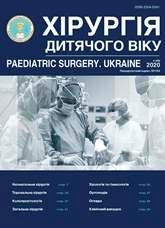Is an empirical approach to performing access in pediatric surgery in children safe?
DOI:
https://doi.org/10.15574/PS.2020.69.43Keywords:
pilonidal disease, children, morphometry, surgical interventionAbstract
Objective: to determine the topical localization of the structural components of the anal sphincter and to formulate the basic postulates of the formation of safe anatomical access in pilonidal disease surgery in children.
Materials and methods: the study was conducted on the corpses of 10 children who had no lifelong pathology of the sacrococcygeal region and pelvis aged 12 to 17 years, including 5 girls and 5 boys. Soft tissue columns 1 cm wide and up to 5 cm long were prepared at a distance of 1 cm from the anus by 12 h, 3 h, 6 h and 9 h according to the dial in the back position. After preparation and fixation of the drugs, their staining was performed and cross-sections of anal sphincters 5–7 μm thick were made. The analysis of the received morphometric data is carried out.
The results of the study: it was found that the cross-sectional area of the bundle of muscle fibers of the external sphincter of the anus on average in adolescents ranged from 448±32 μm2 to 412±24 μm2. The diameter of its muscle fibers was 13.02±1.56 μm, and the bulk density of muscle fibers is 96.12±1.34%. Regarding the length of the internal anal sphincter, it was found that it is almost the same in different areas and is 1.3±0.03 at the level of 3 and 12 hours, 1.3±0.07 at the level of 6 hours and 1.2±0.03 at the level of 9 hours. In the study of the linear dimensions of the length of different portions of external anal sphincter in certain places of the biopsy revealed a predominance of parameters that were determined at 6 hours, respectively, 5.7±0.06 cm against 4.3±0.04 cm at 3 hours, and 12 hours, respectively 5.1±0.06 cm against 4.3±0.03 cm at 9 years. The thickness of the external sphincter of the anus at 6 hours, respectively 26.7±0.61 mm against 18.5±0.19 mm at 3 hours, (<0.01) and 12 hours, respectively 23.9±0.33 mm against 18.4±0.19 mm at 9 hours. Diameters of separate muscular fibers and bundles were explored. It is established that the average diameter of a muscle fiber makes 13.7±0.18 microns, and the average diameter of a muscular bundle is equal to 435.9±5.15 microns.
Conclusions. 1. Existing anatomical descriptions of anal sphincters need in the modern world more thorough research to prevent their injury during surgery. 2. The external anal sphincter has the spatial form of the three-storeyed oval structure extended in the front-back direction with dominance of the caudal muscular portion. 3. When performing radical surgical interventions for pilonidal disease in children by cleft-lift method, it is necessary to complete the edge of surgical access at a distance of not less than 3 cm to the edge of the anal sphincter.
The research was carried out in accordance with the principles of the Helsinki Declaration. The study protocol was approved by the Local Ethics Committee of participating institution. The informed consent of the patient was obtained for conducting the studies.
References
Anderson A. (1847). Hair extracted from an ulcer. Boston Med. Surgical Journal. 36(4): 74-76. https://doi.org/10.1056/NEJM184702240360402
Bascom J. (1980). Pilonidal disease: origin from follicles of hairs and results of follicle removal as treatment. Surgery. 87(5): 567-572.
Karydakis GE. (1992). Easy and successful treatment of pilonidal sinus after explanation of its causative process. Aust. N Z J Surg. 62(5): 385-389; https://doi.org/10.1111/j.1445-2197.1992.tb07208.x; PMid:1575660
Konoplitskyi V, Shavliuk R, Dmytriiev D, Dmytriiev K, Kyrychenko O, Zaletskyi B, Olkhomiak O. (2019). Pilonidal disease: changes in understanding of etiology, pathogenesis and approach to treatment. Wiadomosci Lekarskie. Warsaw. Poland. 72(8): 1559-1565. https://doi.org/10.36740/WLek201908125; PMid:32012508
Konoplytsky VS, Shavliuk RV, Shavliuk VM. (2019). Pilonidal desease in children. Are all issues of pathogenesis solved? Hospital Surgery. Journal named by L.Ya. Kovalchuk. (3): 68-74. https://doi.org/10.11603/2414-4533.2019.3.10549
Poverin GV, Evdokimov AN. (2019). Kistyi kopchika u detey (klinika, diagnostika i hirurgicheskoe lecheniya. Rossiyskiy vestnik detskoy hirurgii, anesteziologii i reanimatologii. 9(2): 105–120.
Downloads
Published
Issue
Section
License
The policy of the Journal “PAEDIATRIC SURGERY. UKRAINE” is compatible with the vast majority of funders' of open access and self-archiving policies. The journal provides immediate open access route being convinced that everyone – not only scientists - can benefit from research results, and publishes articles exclusively under open access distribution, with a Creative Commons Attribution-Noncommercial 4.0 international license(СС BY-NC).
Authors transfer the copyright to the Journal “PAEDIATRIC SURGERY.UKRAINE” when the manuscript is accepted for publication. Authors declare that this manuscript has not been published nor is under simultaneous consideration for publication elsewhere. After publication, the articles become freely available on-line to the public.
Readers have the right to use, distribute, and reproduce articles in any medium, provided the articles and the journal are properly cited.
The use of published materials for commercial purposes is strongly prohibited.

